Tryon Hall was the first large estate built in the Massapequas by a Jones family member. The next estate was named Massapequa Manor and was completed in 183 7. In this case, the builder was also a judge, as was David Jones of Tryon Hall. His name was David S. Jones, son of Samuel Jones, who was a grandson of Thomas Jones. Samuel became a Judge after the Revolution and is known as the “Father of the New York Bar” for organizing the legal profession and the court system in New York State. He was also instrumental in securing ratification of the U. S. Constitution by New York State’s delegation in 1788.
7. In this case, the builder was also a judge, as was David Jones of Tryon Hall. His name was David S. Jones, son of Samuel Jones, who was a grandson of Thomas Jones. Samuel became a Judge after the Revolution and is known as the “Father of the New York Bar” for organizing the legal profession and the court system in New York State. He was also instrumental in securing ratification of the U. S. Constitution by New York State’s delegation in 1788.
David S. Jones was born in 1777 and died in 1848. He graduated from Columbia College in 1796 and held several positions in state and local government, including New York City Corporation Counsel from 1813 to 1816. He was later named a Judge in Queens County, following in his father’s and grandfather’s footsteps. In 1836, he retired and built a large mansion on the east bank of the Massapequa River. The Manor was a large stone structure, with 11 steps leading up to an extensive front porch, with two mahogany front doors opening into a wide and deep parlor. Four Greek columns adorned the front and the manor was reached by a long circular driveway. There were 20 rooms inside, with the smaller third floor rooms occupied by servants. The building faced onto Merrick Road, with the Massapequa River to the west. There were several small buildings for servants and equipment behind and to the east, as well as a polo field and a racetrack. The property ran as far north as today’s Massapequa Avenue and as far east as Old Grace Church.
In order to improve the view looking westward, David Jones dammed Massapequa River several hundred feet north of Merrick Road, drying out an area that became Massapequa Lake. He employed laborers to dig out the area, using teams of horses pulling metal scoops, and piling dirt along its sides to create a shore for his 100-acre lake. A large boathouse was built on the east shore, with a fireplace, a kitchen, a dining area with a dance floor and a deck with a railing encircling it. The Joneses would entertain guests and would launch rowboats that were used to explore the lake.
David Jones also created an island in the middle, which he named Mary’s Island in honor of his wife Mary Clinton, the daughter of Governor De Witt Clinton. Mary was David’s third wife, his first two wives having died during childbirth. Strikingly, she had six children, four of whom died in childbirth or shortly thereafter. In fact, David had 18 children with his three wives, and only seven of them survived to adulthood. His history is a clear example of the difficulties related to childbirth experienced by so many people in the 1800s, even people as wealthy and influential as the Joneses, who would have had access to quality medical care.
David Jones experienced financial difficulties after completing Massapequa Manor and was forced to return to work in New York City. He built a small house in Maspeth and spent most of his time there. Toward the end of his life, he sold Massapequa Manor to his cousin William Floyd-Jones, who owned it into the 1880s and gave it to his daughter Jennie Floyd-Jones. Jennie was married to William Robison, who owned one of the first automobiles driven on Long Island. He was known as a daredevil for riding his car as fast as forty miles per hour on roads that were little more than dirt paths.
Massapequa Manor passed from the Jones/Floyd-Jones family when the Robisons sold it to the Carroon family in the early 1900s. They lived there until after World War II. It was during this time that the lake became known as Carroon’s Lake and is still called that today by people who associate it with the owners. As the population increased, the lake became very popular for fishing in the summers and ice skating in the winters. Population growth, as well as the expenses of maintaining such a large building and several related buildings, led the Carroons to sell it to a developer, who planned to construct homes on the several acres. The manor lay empty and was used by vagrants, teenagers and others who were looking for someplace to hang out.
On Nov. 30, 1952 the building caught fire and burned to the ground very quickly, allowing the developer to build many houses on the extensive property. The present names of roads such as Cambridge, Oxford, Polo, Surrey and Rugby attest to the old-English background of the manor property. These roads are arranged irregularly in a meandering fashion, reflecting the pastoral character of the area and underlining its historical significance.
George Kirchmann is a trustee of the Historical Society of the Massapequas. Email him at gvkirch@optonline.net.
































